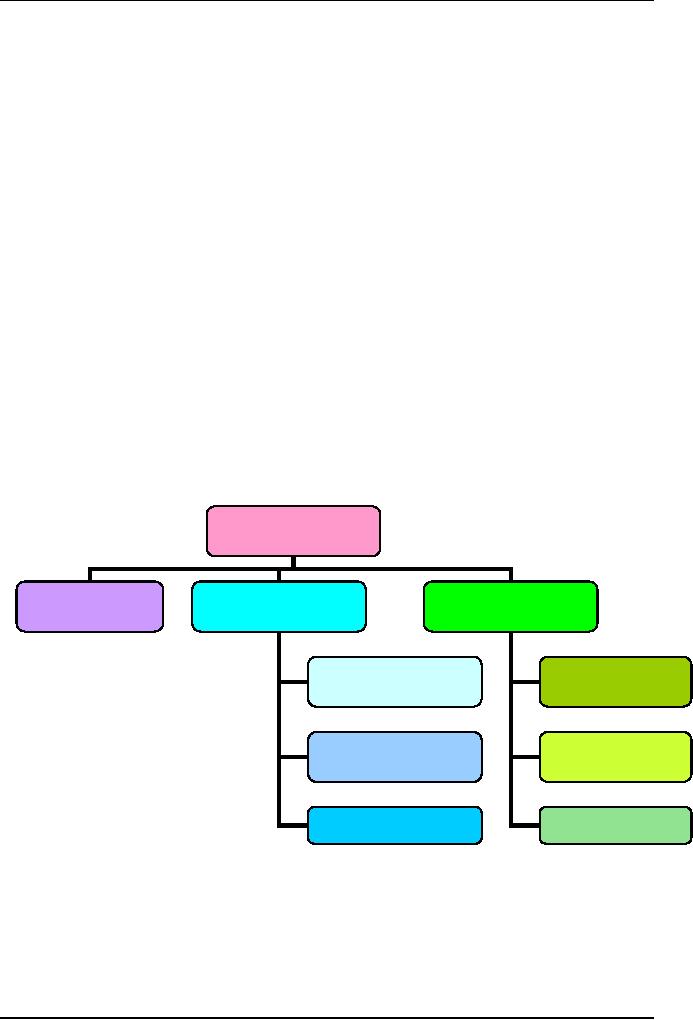 |
Risk & Change Management Concepts |
| << Risk and Change Management: Risk Management Concepts |
| Risk Management Process >> |

Software
Project Management
(CS615)
LECTURE
# 40
9.
Risk and Change
Management
9.1
Fundamentals
·
What
is it?
Change
Management is the
process by which changes to
the Project's scope,
deliverables,
timescales or resources are formally
defined, evaluated and
approved
prior to implementation.
A core
aspect of the Project
Manager's role is to manage change
within the
project
successfully. This is achieved by
understanding the business and
system
drivers
requiring the change, documenting
the benefits and costs of
adopting the
change and
formulating a structured plan
for implementing the
change.
To
formally request a change, it is often
necessary to complete a Change
Form.
The
change request details may then be
recorded within a Change Register.
Risk
Management is the
process by which risks to
the project (e.g. to the
scope,
deliverables,
timescales or resources) are formally
identified, quantified and
managed
during the project.
A project
risk may be identified at
any stage of the project by
completing a Risk
Form and
recording the relevant risk
details within the Risk
Register.
First,
risk
concerns future happenings.
Today and yesterday are
beyond active
concern,
as we are already reaping
what was previously sowed by our
past
actions.
The question is; can we,
therefore, by changing our
actions today, create
an
opportunity for a different and
hopefully better situation
for ourselves
tomorrow.
This
means, second, that
risk involves change, such as in
changes of mind,
opinion,
actions, or places...
[Third] risk
involves choice, and the
uncertainty that choice
itself entails. Thus
paradoxically,
risk, like death and taxes, is one of the
few certainties of
life.
·
Who
does it?
Everyone
involved in the software
process managers, software engineers
and
customers
- participate in risk analysis and
management
·
Why
is it important?
332

Software
Project Management
(CS615)
Think
about the Boy Scout
motto: "Be prepared" Software is a
difficult
undertaking.
Lots of things can go wrong, and
frankly, many often do.
It's for this
reason
that being prepared, understanding
the risks and taking
preventive
measures
to avoid or manage them is a
key element of good software
project
management.
·
What
are the steps?
Recognizing
what can go wrong is the
first step, called - risk
identification. Next,
each
risk is analyzed to determine
the likelihood that it will
occur and the damage
that it
will do if it does occur. Once
this information is established, risks
are
ranked by
probability and impact. Finally, a
plan is developed to manage
those
risks
with high probability and
high impact.
·
What
is the work product?
A risk
mitigation monitoring and management (RMMM)
plan or a set of risk
information
sheets is produced.
·
How
do I ensure that I've done
it right?
The
risks that are analyzed and
managed should be derived
from thorough study
of the
people, the product, the
process and the project. The
RMMM should be
revisited
as the project proceeds to ensure
that risks are kept up to
date.
Contingency
plans for risk management
should be realistic.
9.2
Risk
& Change Management
Concepts
Foresight
is an excellent management quality
that can often be cultivated
with
experience.
Indeed, in many cases,
problems can be anticipated.
In such
cases, the manager can plan
for the possibility that a
problem will occur
by
estimating its probability,
evaluating its impact, and
preparing solutions in
advance.
This is referred to as an effective
means of combating
potential
development
problems.
Performing
risk analysis means being
prepared. It is a form of insurance, the
basic
idea
being that if a problem
occurs, a solution is readily
available. Like all
insurance,
risk analysis usually comes
with a price.
The cost
of preparing for the
occurrence of a problem is primarily
the cost of
having
the alternative solution at
hand while the problem
may or may not
occur.
In some
cases, the cost may be
minimal, the time needed to
analyze and document
the
solution, and the time to
track the problem.
In other
cases the cost may be
substantial, for example,
the price of an
alternative
piece of
development equipment.
333

Software
Project Management
(CS615)
In any
case, a problem that has
been analyzed and resolved
ahead of time is far
simpler
to resolve than a problem
that occurs
unexpectedly.
When
risk is considered in the context of
software engineering, three
conceptual
underpinnings
are always in
evidence:
The
future is our concern
what risks might cause
the software project to
go
awry?
Change is
our concern -how will
changes in customer
requirements,
development
technologies, target computers, and
all other entities
connected
to the
project affect timeliness and
overall success?
Last, we
must grapple with choices -
what methods and tools
should we use,
how
many people should be involved,
how much emphasis on quality
is
"enough"?
Risk
analysis and management are a series of
steps that help a software
team to
understand
and manage uncertainty. Many
problems can plague a software
project
A risk is
a potential problem - it might happen, it
might not But regardless of
the
outcome,
it's a really good idea to
identify it, assess its
probability of occurrence,
estimate
its impact, and establish a
contingency plan should the
problem actually
occur.
Any
project can encounter uncertainties in
the form of increased costs,
schedule
delays,
and diminished qualities. Unless
tackled, these uncertainties can lead
to
major
project disasters.
The
uncertainties encountered during
project execution are the
potential project
risks.
Every software project has
to grapple with the new
risks threatening
information
security along with the
conventional risks, such as
hardware failure,
time and
cost escalation, defects, or resource
crunch.
Risk can
be defined as the possibility of
loss. Risk arises due to the
inability to
achieve
objectives within defined
cost, schedule, and technical
constraints.
Risk
has two components:
The
possibility of not achieving a
particular outcome is one,
and
The
result of failing to achieve
the outcome is the
other
The
former is the probability of
loss, and the latter is the
loss. Software
project
management
deals with managing both
these components of
risk.
Risk
management focuses the project manager's
attention on those portions of
the
project
most likely to cause trouble
and compromise participants' win
conditions.
334

Software
Project Management
(CS615)
In other
words, risk management is a set of
actions that helps the
project manager
plan to
deal with uncertain occurrences. It is
through risk management that
project
managers
assess risks and manage to reduce
risks to an acceptable
level.
9.3
Types
of Risks
To be able to
manage project risks, you
must first understand what
constitutes, a
risk. All
uncertain occurrences are not
risks.
Only
those occurrences that have an adverse
impact on the progress of a
project
are
risks to the project.
Risk is
not a bad thing. Risk is
bad only when it results in
loss for an organization.
Unless
there is a potential for
loss, there is no
risk.
Moreover,
loss can be interpreted as either a bad
outcome or a lost
opportunity.
The
tendency of most project
managers is to jump at the
statement this is a
risk.
However,
the desired reaction is to
pre-empt all possible outcome and
plan for
them.
Project risks can be broadly categorized
into development process
risks and
product
risks.
i.
Development
Process Risks
The
risks encountered during
product development are categorized
as
development
process risks.
These
comprise developer errors,
natural disasters, disgruntled
employees,
and poor
management objectives.
Developer
errors could be attributed to
poor training due to
budgetary
constraints
and inadequate skills and software
tools.
Ergonomic
problems, environment problems, and
interruptions or distractions
at office
also account for developer
risks.
Other
risks in this category
include problems in personnel
acquisition and
retention.
Similarly,
natural disasters such as
flood, cyclone, fire, storm,
and snowfall
are also
risks to a project.
Disgruntled
employees can also become a risk to an
organization. For
example,
a sacked employee can use password
snuffers to gain
unauthorized
access. A
dismissed person can flood the
system with senseless
messages. A
335

Software
Project Management
(CS615)
disgruntled
employee can also try to sabotage
the project work by
destroying
files and
programs.
A poorly
defined management objective is another
development process
risk.
If the
language in the management objective is
ambiguous and not
stated
clearly,
the risk management program will
not function
properly.
Narrowly
focused and changing objectives
that are not updated can also
be
counted
as risks.
Lack of
contingency plans, incomplete cost
estimates, and unrealistic
schedules
are also potential risks in a
project.
Similarly,
unrealistic performance standards
are also potential risks to
the
development
process.
Other
possible risks include contractual
risks, technological risks,
and
inadequate
documentation of other concurrent
projects.
ii.
Product
Risks
Product
risks crop up in the form of
changing requirements during
product
development.
Incomplete
and unclear requirements are a
risk to the product
during
development.
Similarly,
problems in meeting design specifications
can also be categorized
as risk
to product development.
Risks
could arise if the project
deliverables or objectives are
not clearly
defined
or if technical data is
missing.
The
possibility of several alternatives at
any given time during
the project is
also a
cause of concern. If errors
are not recognized during
the design phase,
they
could turn into risks
for the project.
Similarly,
risks could arise due to the
size and complexity of the product
or
while
achieving client acceptance of
the product.
Note:
The
key idea in risk management is
not to wait for a risk to
materialize and
become
a problem. The objective of
risk management is to ensure
that for
each
perceived risk; you know well in
advance how to tackle
it.
336

Software
Project Management
(CS615)
9.4
Risk
Management Process
The
process of risk management begins during
the analysis phase of
software
development
life cycle. However, the
actual process of managing
risks continues
throughout
the product development
phase.
Risk
management is a dynamic process because
it deals with the activities
that are
yet to
happen.
Risk
management has a two-fold agenda.
First, deciding actions for
preventing
risks
from happening, and second, deciding
actions for tackling risks
that
materialize.
Therefore,
risk management is all about
pre-empting a risk, coming up
with a plan
for
resolving the risk, and
finally executing the
plan.
Figure 1
displays the steps of the
risk management process. Formally,
articulated,
risk
management process consists of three
steps:
4.
Risk identification
5.
Risk analysis
6.
Risk mitigation
Figure
1: Risk
Management Process
Risk
Management
Risk
Risk
Risk
Identification
Analysis
Mitigation
Risk
Probability
Risk
Avoidance
Risk
Impact
Risk
Monitoring
Contingency
Risk
Factor
Planning
337
Table of Contents:
- Introduction & Fundamentals
- Goals of Project management
- Project Dimensions, Software Development Lifecycle
- Cost Management, Project vs. Program Management, Project Success
- Project Management’s nine Knowledge Areas
- Team leader, Project Organization, Organizational structure
- Project Execution Fundamentals Tracking
- Organizational Issues and Project Management
- Managing Processes: Project Plan, Managing Quality, Project Execution, Project Initiation
- Project Execution: Product Implementation, Project Closedown
- Problems in Software Projects, Process- related Problems
- Product-related Problems, Technology-related problems
- Requirements Management, Requirements analysis
- Requirements Elicitation for Software
- The Software Requirements Specification
- Attributes of Software Design, Key Features of Design
- Software Configuration Management Vs Software Maintenance
- Quality Assurance Management, Quality Factors
- Software Quality Assurance Activities
- Software Process, PM Process Groups, Links, PM Phase interactions
- Initiating Process: Inputs, Outputs, Tools and Techniques
- Planning Process Tasks, Executing Process Tasks, Controlling Process Tasks
- Project Planning Objectives, Primary Planning Steps
- Tools and Techniques for SDP, Outputs from SDP, SDP Execution
- PLANNING: Elements of SDP
- Life cycle Models: Spiral Model, Statement of Requirement, Data Item Descriptions
- Organizational Systems
- ORGANIZATIONAL PLANNING, Organizational Management Tools
- Estimation - Concepts
- Decomposition Techniques, Estimation – Tools
- Estimation – Tools
- Work Breakdown Structure
- WBS- A Mandatory Management Tool
- Characteristics of a High-Quality WBS
- Work Breakdown Structure (WBS)
- WBS- Major Steps, WBS Implementation, high level WBS tasks
- Schedule: Scheduling Fundamentals
- Scheduling Tools: GANTT CHARTS, PERT, CPM
- Risk and Change Management: Risk Management Concepts
- Risk & Change Management Concepts
- Risk Management Process
- Quality Concept, Producing quality software, Quality Control
- Managing Tasks in Microsoft Project 2000
- Commissioning & Migration